Universal Snow Avalanche Modeling Index Based on SAFI–Flow-R Approach in Poorly-Gauged Regions
Abstract
:1. Introduction
2. Materials and Methods
2.1. Study Area
2.2. Methodology
2.2.1. Snow Avalanche Formation Index (SAFI)
2.2.2. Flow-R Software
3. Results
4. Discussion
- −
- Universality of the model. Due to the application of only the main natural conditions, avalanche modeling SAFI–Flow-R approach enables spatial modeling of avalanches in different mountain regions around the world (Šar Mountains, Alps, Andes, Himalayas, Rocky Mountains, Caucasus, etc.);
- −
- Identification of vulnerable areas at the regional level. In a relatively short period, results on the propagation of avalanches can be obtained for territories with an area of more than 1000 km2;
- −
- Compact modeling of snow avalanches from the starting zone to the run-out zone;
- −
- Avalanche spatial modeling is possible with or without a snow avalanche inventory. Unlike many statistical methods and machine learning models, SAFI–Flow-R can offer relevant results without historical data, which significantly facilitates the work of researchers in parts of mountain regions where there is no avalanche inventory;
- −
- Simple application and data processing. All data (snow cover, terrain slope, and land use) are open data that can be processed using GIS tools and processing of satellite images.
5. Validation of Model
6. Conclusions
Author Contributions
Funding
Data Availability Statement
Acknowledgments
Conflicts of Interest
References
- Hao, J.; Mind’je, R.; Liu, Y.; Huang, F.; Zhou, H.; Li, L. Characteristics and hazards of different snow avalanche types in a continental snow climate region in the Central Tianshan Mountains. J. Arid Land 2021, 13, 317–331. [Google Scholar] [CrossRef]
- Wen, H.; Wu, X.; Liao, X.; Wang, D.; Huang, K.; Wünnemann, B. Application of machine learning methods for snow avalanche susceptibility mapping in the Parlung Tsangpo catchment, southeastern Qinghai-Tibet Plateau. Cold Reg. Sci. Technol. 2022, 198, 103535. [Google Scholar] [CrossRef]
- Favier, P.; Eckert, N.; Faug, T.; Bertrand, D.; Ousset, I.; Candia, G.; Llera, J.C.D.L. A framework to account for structural damage, functional efficiency and reparation costs within the optimal design of countermeasures: Application to snow avalanche risk mitigation. Cold Reg. Sci. Technol. 2022, 199, 103559. [Google Scholar] [CrossRef]
- Bian, R.; Huang, K.; Liao, X.; Ling, S.; Wen, H.; Wu, X. Snow avalanche susceptibility assessment based on ensemble machine learning model in the central Shaluli Mountain. Front. Earth Sci. 2022, 10, 880711. [Google Scholar] [CrossRef]
- Valero, C.V.; Wever, N.; Bühler, Y.; Stoffel, L.; Margreth, S.; Bartelt, P. Modelling wet snow avalanche runout to assess road safety at a high-altitude mine in the central Andes. Nat. Hazards Earth Syst. Sci. 2016, 16, 2303–2323. [Google Scholar] [CrossRef]
- McClung, D.M. Avalanche character and fatalities in the high mountains of Asia. Ann. Glaciol. 2016, 57, 114–118. [Google Scholar] [CrossRef]
- Kumar, S.; Srivastava, K.P.; Snehmani; Bhatiya, S. Geospatial probabilistic modelling for release area mapping of snow avalanches. Cold Reg. Sci. Technol. 2019, 165, 102813. [Google Scholar] [CrossRef]
- Yang, J.; Li, C.; Li, L.; Ding, J.; Zhang, R.; Han, T.; Liu, Y. Automatic Detection of Regional Snow Avalanches with Scattering and Interference of C-band SAR Data. Remote Sens. 2020, 12, 2781. [Google Scholar] [CrossRef]
- European Avalanche Warning Services [EAWS]. Fatalities. Available online: https://www.avalanches.org/fatalities/ (accessed on 16 March 2024).
- Rafique, A.; Dasti, M.Y.S.; Ullah, B.; Awwad, F.A.; Ismail, E.A.A.; Saqib, Z.A. Snow Avalanche Hazard Mapping Using a GIS-Based AHP Approach: A Case of Glaciers in Northern Pakistan from 2012 to 2022. Remote Sens. 2023, 15, 5375. [Google Scholar] [CrossRef]
- Germain, D.; Filion, L.; Hétu, B. Snow avalanche regime and climatic conditions in the Chic-Choc Range, eastern Canada. Clim. Chang. 2009, 92, 141–167. [Google Scholar] [CrossRef]
- Bair, E.H.; Rittger, K.; Ahmad, J.A.; Chabot, D. Comparison of modeled snow properties in Afghanistan, Pakistan, and Tajikistan. Cryosphere 2020, 14, 331–347. [Google Scholar] [CrossRef]
- Tremper, B. Staying Alive in Avalanche Terrain, 3rd ed.; Mountaineers Books: Seattle, WA, USA, 2018; pp. 1–352. [Google Scholar]
- Bulajić, Ð.B.; Bajić, S.; Stojnić, N. The effects of geological surroundings on earthquake-induced snow avalanche prone areas in the Kopaonik region. Cold Reg. Sci. Technol. 2018, 149, 29–45. [Google Scholar] [CrossRef]
- Durlević, U.; Novković, I.; Lukić, T.; Valjarević, A.; Samardžić, I.; Krstić, F.; Batoćanin, N.; Mijatov, M.; Ćurić, V. Multihazard susceptibility assessment: A case study – Municipality of Štrpce (Southern Serbia). Open Geosci. 2021, 13, 1414–1431. [Google Scholar] [CrossRef]
- Durlević, U.; Valjarević, A.; Novković, I.; Ćurčić, N.B.; Smiljić, M.; Morar, C.; Stoica, A.; Barišić, D.; Lukić, T. GIS-Based Spatial Modeling of Snow Avalanches Using Analytic Hierarchy Process. A Case Study of the Šar Mountains, Serbia. Atmosphere 2022, 13, 1229. [Google Scholar] [CrossRef]
- Durlević, U.; Novković, I.; Bajić, S.; Milinčić, M.; Valjarević, A.; Čegar, N.; Lukić, T. Snow Avalanche Hazard Prediction Using the Best-Worst Method—Case Study: The Šar Mountains, Serbia. In Advances in Best-Worst Method; Rezaei, J., Brunelli, M., Mohammadi, M., Eds.; Springer: Cham, Switzerland, 2023; pp. 211–216. [Google Scholar] [CrossRef]
- Simenhois, R.; Birkeland, K. The Extended Column Test: Test effectiveness, spatial variability, and comparison with the Propagation Saw Test. Cold Reg. Sci. Technol. 2009, 59, 210–216. [Google Scholar] [CrossRef]
- Veitinger, J.; Purves, S.R.; Sovilla, B. Potential slab avalanche release area identification from estimated winter terrain: A multi-scale, fuzzy logic approach. Nat. Hazards Earth Syst. Sci. 2016, 16, 2211–2225. [Google Scholar] [CrossRef]
- Nasery, S.; Kalkan, K. Snow avalanche risk mapping using GIS-based multi-criteria decision analysis: The case of Van, Turkey. Arab. J. Geosci. 2021, 14, 782. [Google Scholar] [CrossRef]
- Akay, H. Spatial modeling of snow avalanche susceptibility using hybrid and ensemble machine learning techniques. Catena 2021, 206, 105524. [Google Scholar] [CrossRef]
- Choubin, B.; Borji, M.; Mosavi, A.; Hosseini, S.F.; Singh, P.V.; Shamshirband, S. Snow avalanche hazard prediction using machine learning methods. J. Hydrol. 2019, 577, 123929. [Google Scholar] [CrossRef]
- Konurhan, Z.; Yücesan, M.; Gul, M. Avalanche Risk Analysis by a Combined Geographic Information System and Bayesian Best-Worst Method. In Advances in Best-Worst Method; Rezaei, J., Brunelli, M., Mohammadi, M., Eds.; Springer: Cham, Switzerland, 2023; pp. 193–210. [Google Scholar] [CrossRef]
- Srejić, T.; Manojlović, S.; Sibinović, M.; Bajat, B.; Novković, I.; Milošević, M.V.; Carević, I.; Todosijević, M.; Sedlak, M.G. Agricultural Land Use Changes as a Driving Force of Soil Erosion in the Velika Morava River Basin, Serbia. Agriculture 2023, 13, 778. [Google Scholar] [CrossRef]
- Novkovic, I.; Markovic, G.B.; Lukic, D.; Dragicevic, S.; Milosevic, M.; Djurdjic, S.; Samardzic, I.; Lezaic, T.; Tadic, M. GIS-Based Forest Fire Susceptibility Zonation with IoT Sensor Network Support, Case Study—Nature Park Golija, Serbia. Sensors 2021, 21, 6520. [Google Scholar] [CrossRef] [PubMed]
- Micić Ponjiger, T.; Lukić, T.; Wilby, R.L.; Marković, S.B.; Valjarević, A.; Dragićević, S.; Gavrilov, M.B.; Ponjiger, I.; Durlević, U.; Milanović, M.M.; et al. Evaluation of Rainfall Erosivity in the Western Balkans by Mapping and Clustering ERA5 Reanalysis Data. Atmosphere 2023, 14, 104. [Google Scholar] [CrossRef]
- Durlević, U. Assessment of torrential flood and landslide susceptibility of terrain: Case study—Mlava River Basin (Serbia). Bull. Serb. Geogr. Soc. 2021, 101, 49–75. [Google Scholar] [CrossRef]
- Valjarević, A.; Morar, C.; Živković, J.; Niemets, L.; Kićović, D.; Golijanin, J.; Gocić, M.; Bursać, N.M.; Stričević, L.; Žiberna, I.; et al. Long Term Monitoring and Connection between Topography and Cloud Cover Distribution in Serbia. Atmosphere 2021, 12, 964. [Google Scholar] [CrossRef]
- Durlević, U.; Novković, I.; Carević, I.; Valjarević, D.; Marjanović, A.; Batoćanin, N.; Krstić, F.; Stojanović, L.; Valjarević, A. Sanitary landfill site selection using GIS-based on a fuzzy multi-criteria evaluation technique: A case study of the City of Kraljevo, Serbia. Environ. Sci. Pollut. Res. 2023, 30, 37961–37980. [Google Scholar] [CrossRef]
- Kumar, S.; Snehmani; Srivastava, P.K.; Gore, A.; Singh, M.K. Fuzzy–frequency ratio model for avalanche susceptibility mapping. Int. J. Digit. Earth 2016, 9, 1168–1184. [Google Scholar] [CrossRef]
- Varol, N. Avalanche susceptibility mapping with the use of frequency ratio, fuzzy and classical analytical hierarchy process for Uzungol area, Turkey. Cold Reg. Sci. Technol. 2021, 194, 103439. [Google Scholar] [CrossRef]
- Iban, M.C.; Bilgilioglu, S.S. Snow avalanche susceptibility mapping using novel tree-based machine learning algorithms (XGBoost, NGBoost, and LightGBM) with eXplainable Artificial Intelligence (XAI) approach. Stoch. Environ. Res. Risk Assess. 2023, 37, 2243–2270. [Google Scholar] [CrossRef]
- Yariyan, P.; Avand, M.; Abbaspour, A.R.; Karami, M.; Tiefenbacher, P.J. GIS-based spatial modeling of snow avalanches using four novel ensemble models. Sci. Total Environ. 2020, 745, 141008. [Google Scholar] [CrossRef]
- Košová, V.; Molokáč, M.; Čech, V.; Jesenský, M. Avalanche Hazard Modelling within the Kráľova Hoľa Area in the Low Tatra Mountains in Slovakia. Land 2022, 11, 766. [Google Scholar] [CrossRef]
- Martini, M.; Baggio, T.; D’Agostino, V. Comparison of two 2-D numerical models for snow avalanche simulation. Sci. Total Environ. 2023, 896, 165221. [Google Scholar] [CrossRef] [PubMed]
- Kumar, S.; Srivastava, P.K.; Snehmani. Geospatial modelling and mapping of snow avalanche susceptibility. J. Indian Soc. Remote Sens. 2018, 46, 109–119. [Google Scholar] [CrossRef]
- Xi, N.; Mei, G. Avalanche Susceptibility Mapping by Investigating Spatiotemporal Characteristics of Snow Cover Based on Remote Sensing Imagery along the Pemo Highway—A Critical Transportation Road in Tibet, China. Water 2023, 15, 2743. [Google Scholar] [CrossRef]
- Ćurić, V.; Durlević, U.; Ristić, N.; Novković, I.; Čegar, N. GIS application in analysis of threat of forest fires and landslides in the Svrljiški Timok Basin (Serbia). Bull. Serb. Geogr. Soc. 2022, 102, 107–130. [Google Scholar] [CrossRef]
- Nikolić, G.; Vujović, F.; Golijanin, J.; Šiljeg, A.; Valjarević, A. Modelling of Wildfire Susceptibility in Different Climate Zones in Montenegro Using GIS-MCDA. Atmosphere 2023, 14, 929. [Google Scholar] [CrossRef]
- Hall, D.K.; Riggs, G.A.; Salomonson, V.V. Development of methods for mapping global snow cover using moderate resolution imaging spectroradiometer data. Remote Sens. Environ. 1995, 54, 127–140. [Google Scholar] [CrossRef]
- Copernicus Open Access Hub. Copernicus Data Space Ecosystem. Available online: https://dataspace.copernicus.eu/ (accessed on 29 February 2024).
- Stojković, S.; Marković, D.; Durlević, U. Snow Cover Estimation Using Sentinel-2 High Spatial Resolution Data. A Case Study: National Park Šar Planina (Serbia). In Advanced Technologies, Systems, and Applications VII; Ademović, N., Mujčić, E., Mulić, M., Kevrić, J., Akšamija, Z., Eds.; Springer: Cham, Switzerland, 2023; pp. 507–519. [Google Scholar] [CrossRef]
- Utah Geospatial Resource Center. Utah Avalanche Paths. Available online: https://gis.utah.gov/products/sgid/geoscience/avalanche-paths/ (accessed on 27 February 2024).
- QField Ecosystem Documentation. Available online: https://docs.qfield.org/get-started/ (accessed on 12 February 2024).
- Bhat, I.A.; Bhat, W.A.; Ashan, S.; Shafiq, M.U.; Ahmed, P. Snow avalanche susceptibility along Mughal Road, North-western Himalaya using geospatial techniques. Arab. J. Geosci. 2024, 17, 41. [Google Scholar] [CrossRef]
- Utah Avalanche Center. Blog: Steepness. Available online: https://utahavalanchecenter.org/blog/16386 (accessed on 22 February 2024).
- Alaska Satellite Facility. ALOS PALSAR. Available online: https://search.asf.alaska.edu/#/ (accessed on 10 February 2024).
- Sykes, J.; Toft, H.; Haegeli, P.; Statham, G. Automated Avalanche Terrain Exposure Scale (ATES) mapping—Local validation and optimization in western Canada. Nat. Hazards Earth Syst. Sci. 2024, 24, 947–971. [Google Scholar] [CrossRef]
- ESRI. Sentinel-2 Land Cover Explorer. Available online: https://livingatlas.arcgis.com/landcoverexplorer/#mapCenter=21.076%2C42.197%2C13&mode=step&timeExtent=2017%2C2023&year=2023 (accessed on 12 February 2024).
- Dinić, J. Commune Štrpce, Sirinićka Župa. Trait of Natural Environment; Geographical Institute “Jovan Cvijić” SASA: Belgrade, Serbia, 1990. [Google Scholar]
- Lazarević, R. Šara Mountain Župas: Gora, Opolje and Sredska. Train of Natural Environment; Geographical Institute “Jovan Cvijić” SASA: Belgrade, Serbia, 1994. [Google Scholar]
- QGIS Development Team. QGIS Geographic Information System v3.28.10 with GRASS. Open Source Geospatial Foundation Project. Available online: http://qgis.osgeo.org (accessed on 18 June 2023).
- Vujović, F.; Ćulafić, G.; Valjarević, A.; Brđanin, E.; Durlević, U. Comparative Geomorphometric Analysis of Drainage Basin Using AW3D30 Model in ArcGIS and QGIS Environment: Case Study of the Ibar River Drainage Basin, Montenegro. Agric. For. 2024, 70, 217–230. [Google Scholar] [CrossRef]
- Horton, P.; Jaboyedoff, M.; Rudaz, B.; Zimmermann, M. Flow-R, a model for susceptibility mapping of debris flows and other gravitational hazards at a regional scale. Nat. Hazards Earth Syst. Sci. 2013, 13, 869–885. [Google Scholar] [CrossRef]
- Jaboyedoff, M.; Choffet, M.; Derron, M.H.; Horton, P.; Loye, A.; Longchamp, C.; Mazotti, B.; Michoud, C.; Pedrazzini, A. Preliminary Slope Mass Movement Susceptibility Mapping Using DEM and LiDAR DEM. In Terrigenous Mass Movements; Pradhan, B., Buchroithner, M., Eds.; Springer: Berlin/Heidelberg, Germany, 2012; pp. 109–170. [Google Scholar] [CrossRef]
- Nie, Y.; Li, X.; Zhou, W.; Xu, R. Dynamic hazard assessment of group-occurring debris flows based on a coupled model. Nat. Hazards 2021, 106, 2635–2661. [Google Scholar] [CrossRef]
- Fischer, V.F.; Keiler, M.; Zimmermann, M. Modelling of individual debris flows using Flow-R: A case study in four Swiss torrents. In 13th Congress Interpraevent; Koboltschnig, G., Ed.; International Research Society: Lucerne, Switzerland, 2016; pp. 257–264. Available online: https://interpraevent2016.ch/ (accessed on 22 February 2024).
- Noël, F.; Nordang, S.F.; Jaboyedoff, M.; Digout, M.; Guerin, A.; Locat, J.; Matasci, B. Comparing Flow-R, Rockyfor3D and RAMMS to Rockfalls from the Mel de la Niva Mountain: A Benchmarking Exercise. Geosciences 2023, 13, 200. [Google Scholar] [CrossRef]
- Holmgren, P. Multiple flow direction algorithms for runoff modelling in grid based elevation models: An empirical evaluation. Hydrol. Process. 1994, 8, 327–334. [Google Scholar] [CrossRef]
- Perla, R.; Cheng, T.T.; McClung, D.M. A two-parameter model of snow-avalanche motion. J. Glaciol. 1980, 26, 197–207. [Google Scholar] [CrossRef]
- Bühler, Y.; Kumar, S.; Veitinger, J.; Christen, M.; Stoffel, A.; Snehmani. Automated identification of potential snow avalanche release areas based on digital elevation models. Nat. Hazards Earth Syst. Sci. 2013, 13, 1321–1335. [Google Scholar] [CrossRef]
- Vontobel, I.; Harvey, S.; Purves, R. Terrain analysis of skier-triggered avalanche starting zones. In International Snow Science Workshop Proceedings; Naaim-Bouvet, F., Durand, Y., Lambert, R., Eds.; Anena: Grenoble, France, 2013; pp. 371–375. Available online: https://www.dora.lib4ri.ch/wsl/islandora/object/wsl:17009 (accessed on 22 June 2024).
- Manap, M.A.; Nampak, H.; Pradhan, B. Application of probabilistic-based frequency ratio model in groundwater potential mapping using remote sensing data and GIS. Arab. J. Geosci. 2014, 7, 711–724. [Google Scholar] [CrossRef]
- Bahun, V.M.; Hrvatin, M.; Komac, B. Determining potential snow avalanche release areas by relief analysis. In Preteklost in Prihodnost; Ciglič, R., Čonč, Š., Geršič, M., Perko, D., Valjavec, B.M., Zorn, M., Eds.; Založba ZRC: Ljubljana, Slovenia, 2022; pp. 95–107. [Google Scholar] [CrossRef]
- Komac, B.; Ciglič, R.; Hrvatin, M.; Bahun, V.M.; Štaut, L.; Zorn, M. The Geographical Atlas of Natural Disasters in Slovenia. Geogr. Vestn. 2023, 95, 119–151. [Google Scholar] [CrossRef]
- Komac, B.; Zorn, M. Impact of climate change on snowpack and avalanches in Slovenia: The Soča Valley case study. Geogr. Pol. 2023, 96, 29–51. [Google Scholar] [CrossRef]
- Pavšek, M. Snow Avalanches in Slovenia—Geographical Features and Prevention; Anton Melik Geographical Institute: Ljubljana, Slovenia, 2002; pp. 1–209. (In Slovenian) [Google Scholar] [CrossRef]
- Singh, D.K.; Tanniru, S.; Singh, K.K.; Negi, H.S.; Ramsankaran, R. Passive microwave remote-sensing-based high-resolution snow depth mapping for Western Himalayan zones using multifactor modeling approach. Cryosphere 2024, 18, 451–474. [Google Scholar] [CrossRef]
- Tanniru, S.; Ramsankaran, R. Passive Microwave Remote Sensing of Snow Depth: Techniques, Challenges and Future Directions. Remote Sens. 2023, 15, 1052. [Google Scholar] [CrossRef]
- Krušić, J.; Marjanović, M.; Samardžić-Petrović, M.; Abolmasov, B.; Andrejev, K.; Miladinović, A. Comparison of expert, deterministic and Machine Learning approach for landslide susceptibility assessment in Ljubovija Municipality, Serbia. Geofizika 2017, 34, 251–273. [Google Scholar] [CrossRef]
- Phong, V.T.; Phan, T.T.; Prakash, I.; Singh, S.K.; Shirzadi, A.; Chapi, K.; Ly, H.-B.; Ho, L.S.; Quoc, N.K.; Pham, B.T. Landslide susceptibility modeling using different artificial intelligence methods: A case study at Muong Lay district, Vietnam. Geocarto Int. 2019, 36, 1685–1708. [Google Scholar] [CrossRef]
- Rahmati, O.; Ghorbanzadeh, O.; Teimurian, T.; Mohammadi, F.; Tiefenbacher, J.P.; Falah, F.; Pirasteh, S.; Ngo, P.-T.T.; Bui, D.T. Spatial Modeling of Snow Avalanche Using Machine Learning Models and Geo-Environmental Factors: Comparison of Effectiveness in Two Mountain Regions. Remote Sens. 2019, 11, 2995. [Google Scholar] [CrossRef]
- Čegar, N.; Durlević, U.; Dobrić, M.; Vukašinović, S. A statistical analysis of temperature and precipitation in Belgrade, Serbia (1961–2020). Forum Geogr. 2023, 22, 5–15. [Google Scholar] [CrossRef]
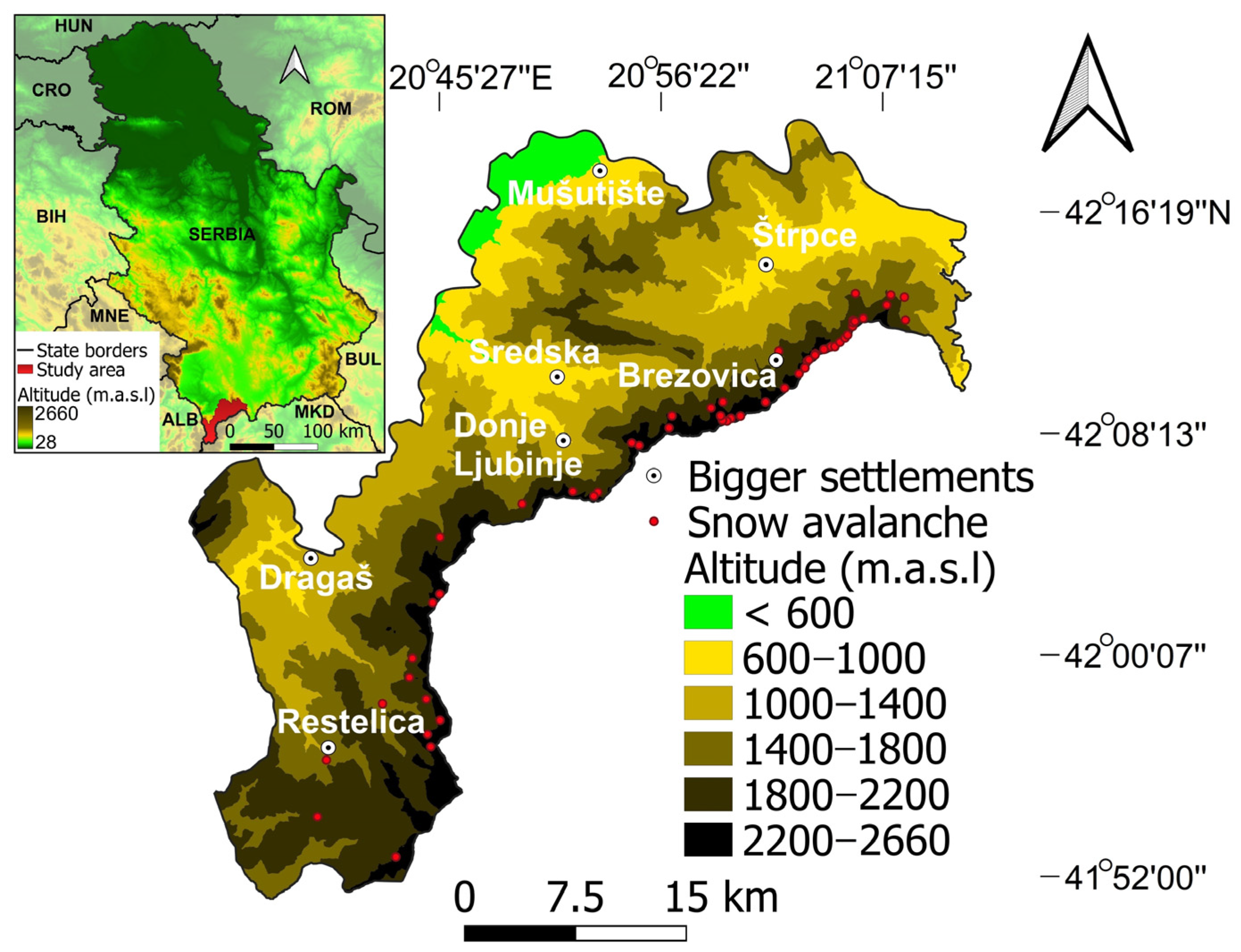
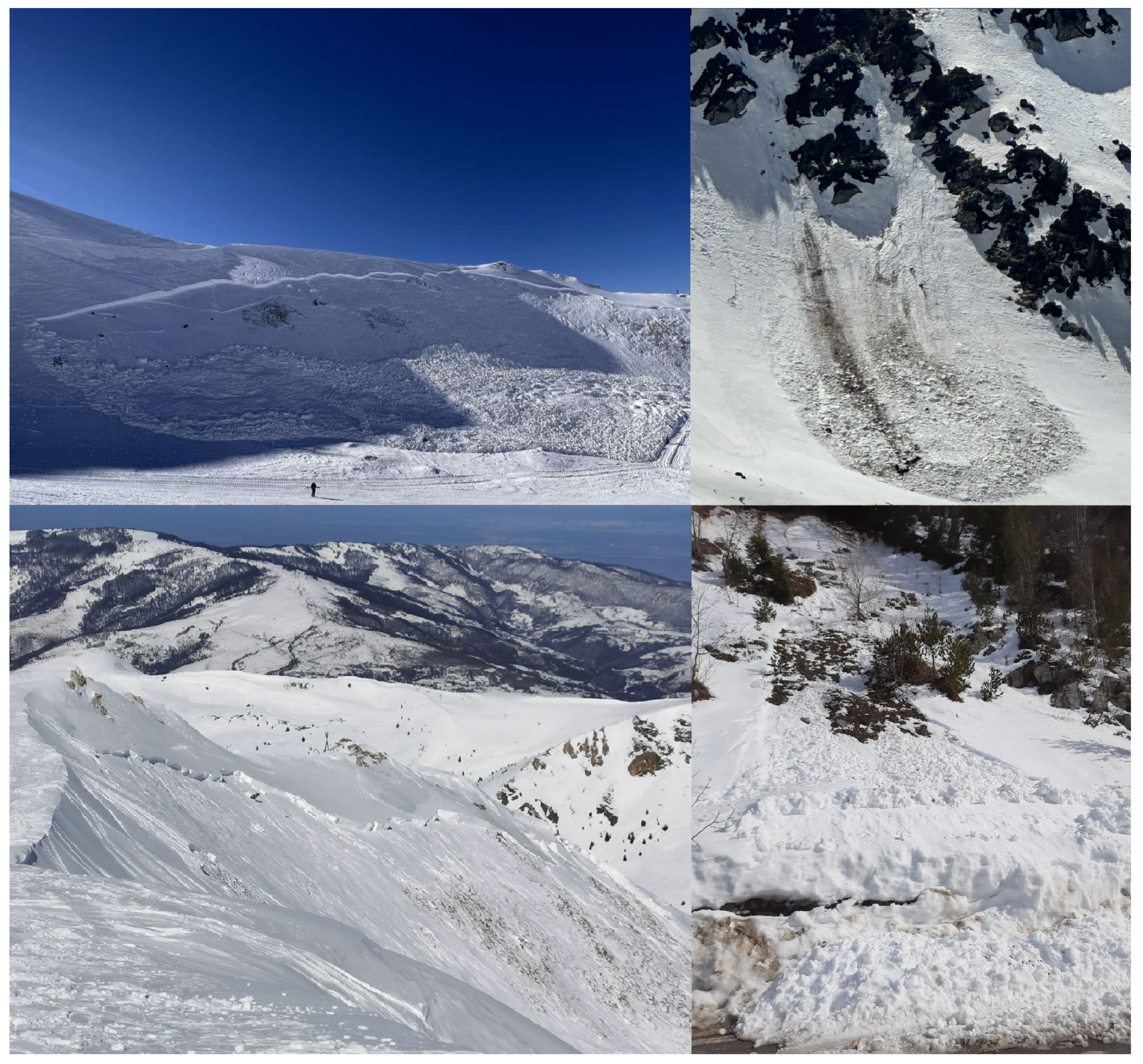
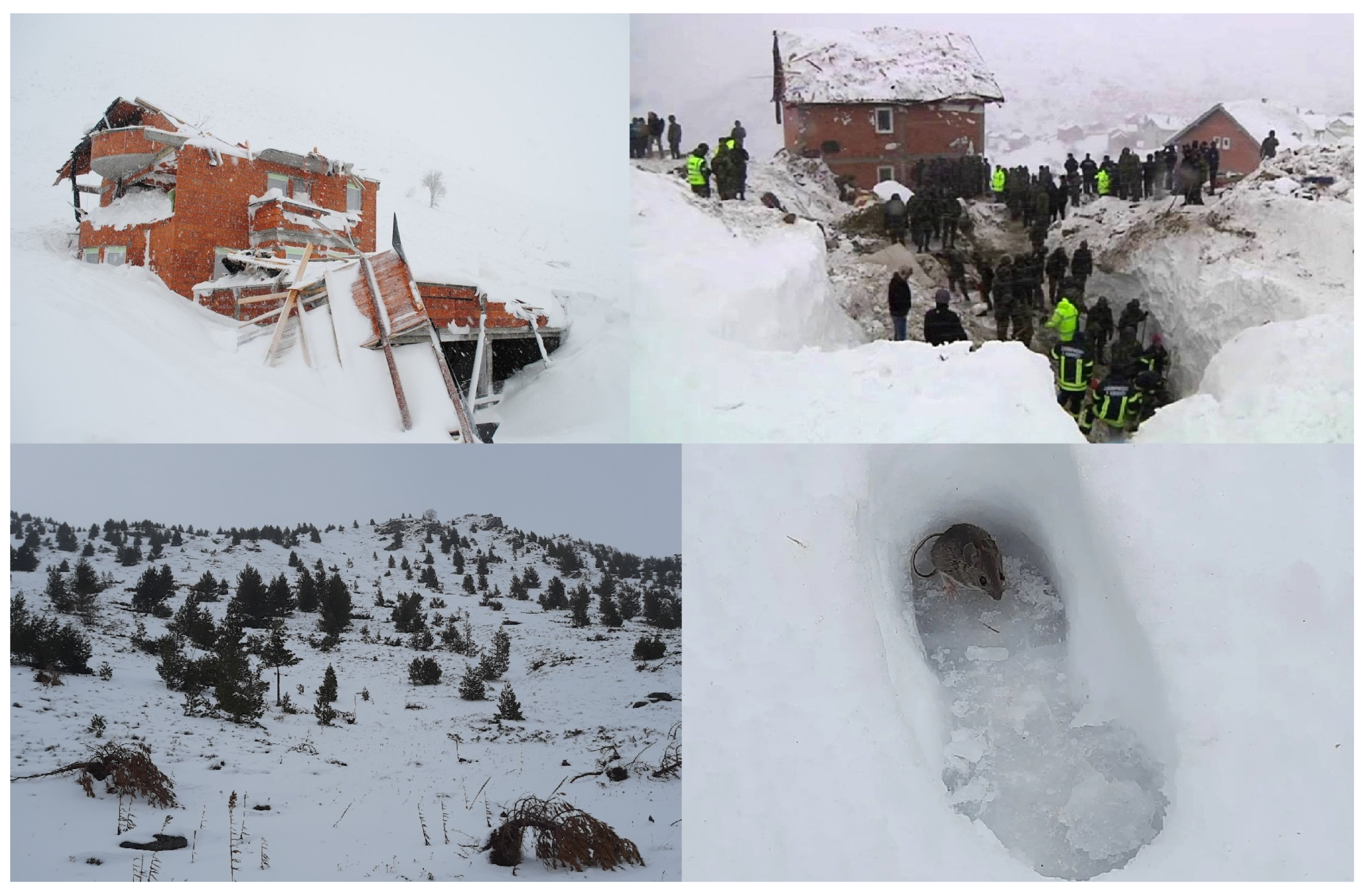
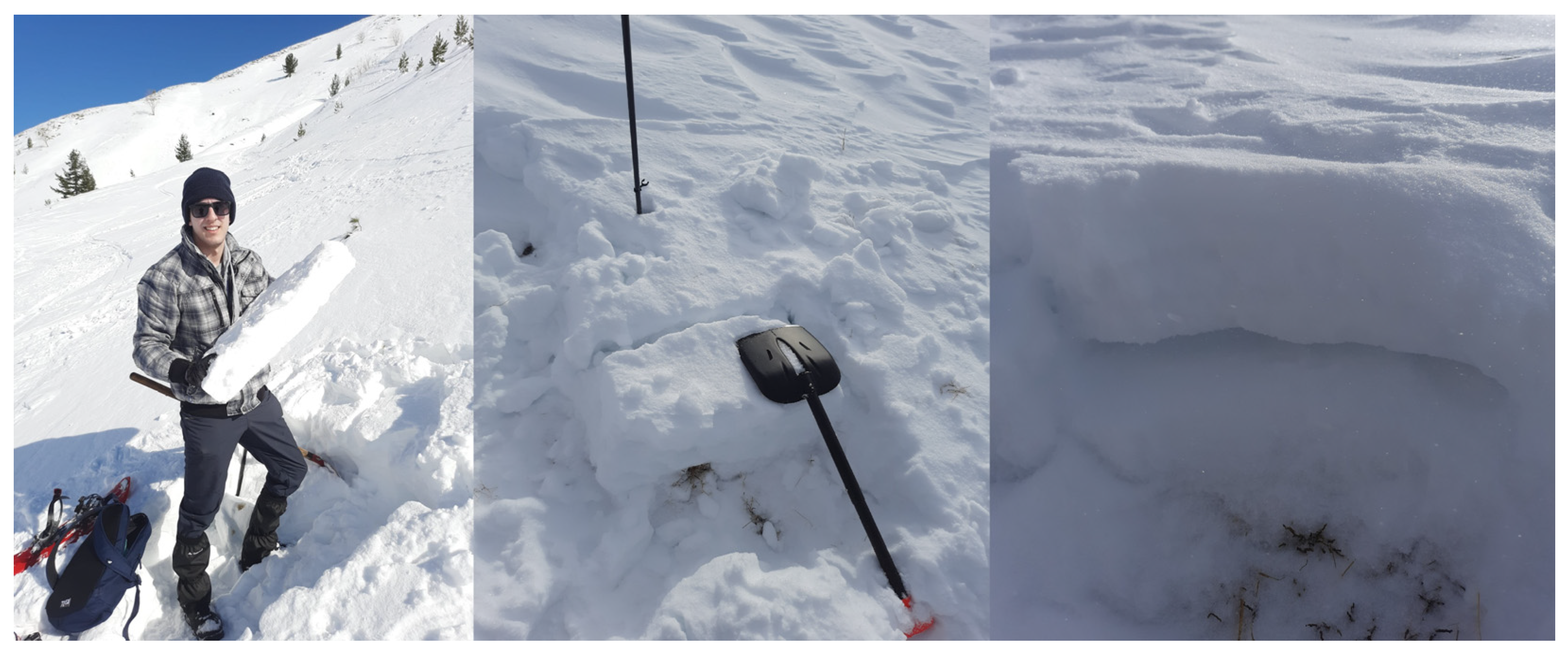



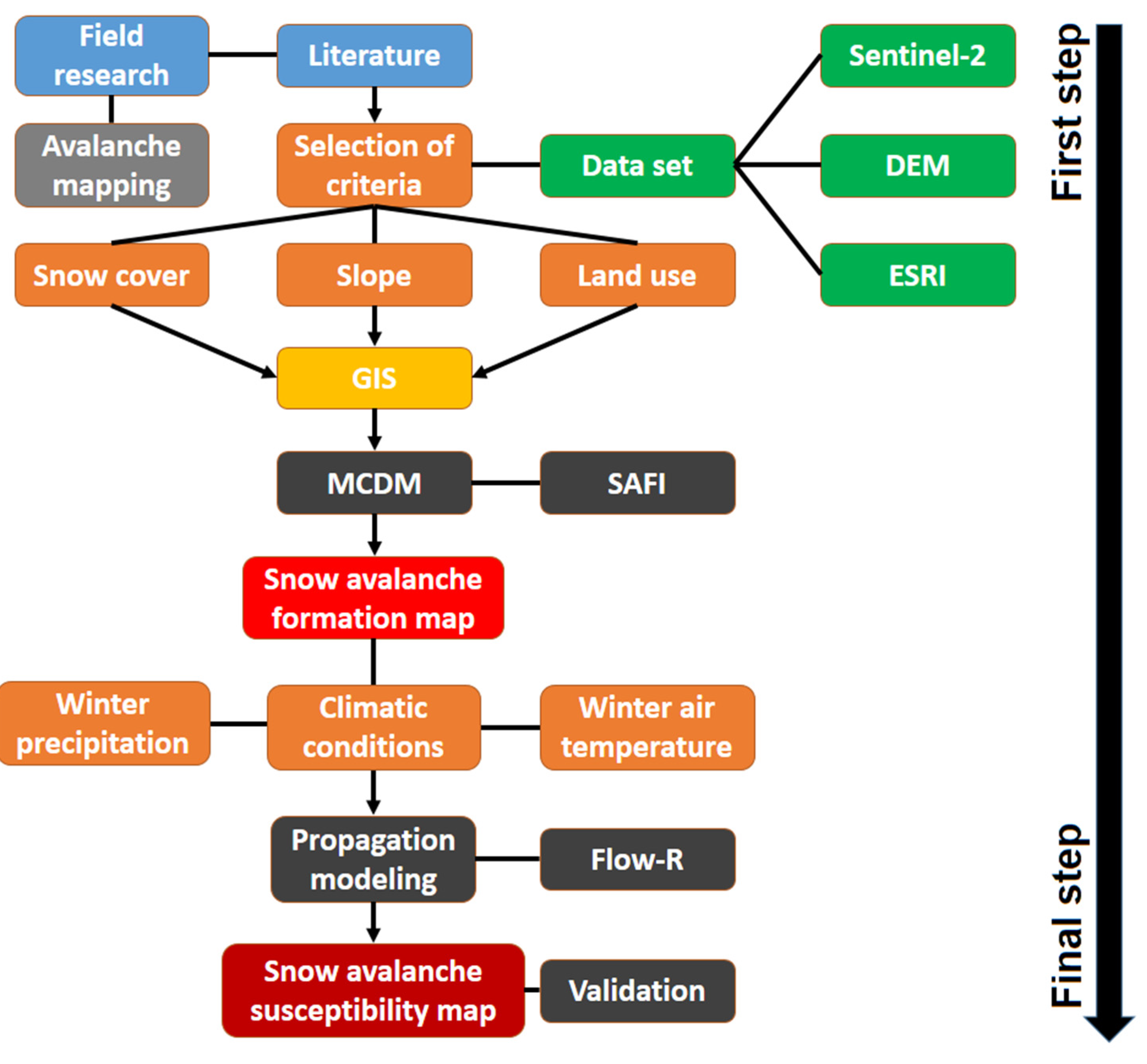

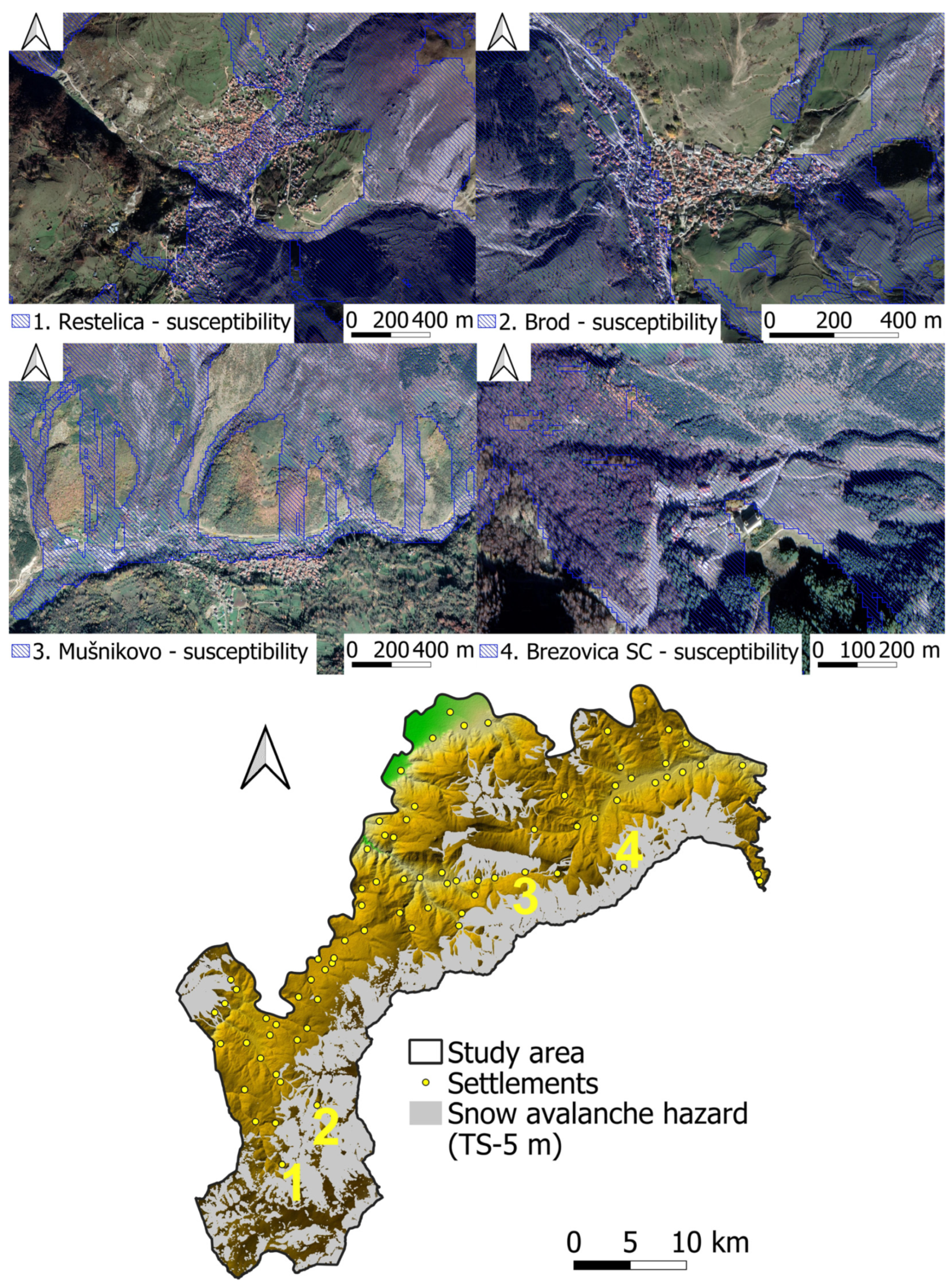
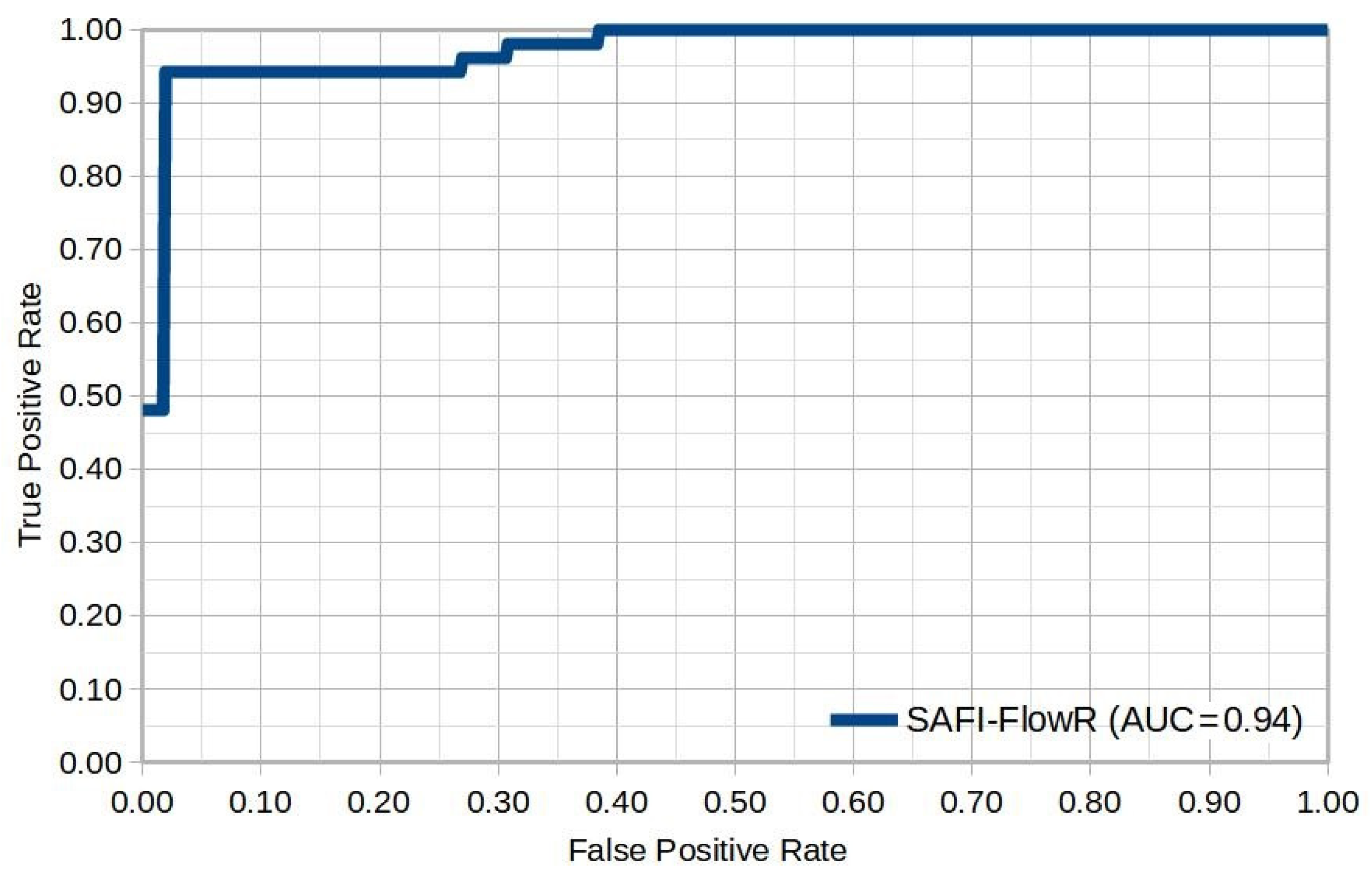
| Avalanche | Latitude (UTM 34N) | Longitude | Altitude (m) | NDSI | Slope (°) | Land Use |
|---|---|---|---|---|---|---|
| 1 | 502066.783 | 4667123.11 | 2294 | 0.73 | 24.4 | Pastures |
| 2 | 503361.101 | 4668079.36 | 2243 | 0.72 | 30.5 | Pastures |
| 3 | 504331.426 | 4669052.444 | 2336 | 0.72 | 48.3 | Pastures |
| 4 | 504889.997 | 4669887.542 | 2387 | 0.70 | 34.5 | Pastures |
| 5 | 505002.319 | 4669989.1 | 2417 | 0.67 | 30.1 | Pastures |
| 6 | 504663.065 | 4669542.353 | 2281 | 0.69 | 27.2 | Pastures |
| 7 | 505436.288 | 4670404.027 | 2407 | 0.65 | 36.4 | Pastures |
| 8 | 505415.59 | 4670319.855 | 2431 | 0.63 | 32.8 | Pastures |
| 9 | 506019.145 | 4670700.147 | 2312 | 0.72 | 59.7 | Pastures |
| 10 | 506503.893 | 4670880.358 | 2234 | 0.68 | 47.8 | Pastures |
| 11 | 506754.34 | 4670882.29 | 2199 | 0.69 | 47.6 | Pastures |
| 12 | 507099.997 | 4671178.686 | 2219 | 0.70 | 35.0 | Pastures |
| 13 | 507443.585 | 4671466.251 | 2213 | 0.68 | 37.5 | Pastures |
| 14 | 507617.655 | 4671671.437 | 2223 | 0.69 | 38.1 | Pastures |
| 15 | 507954.619 | 4672239.668 | 2219 | 0.69 | 30.8 | Pastures |
| 16 | 507990.427 | 4672671.291 | 2028 | 0.76 | 27.8 | Pastures |
| 17 | 507986.908 | 4672491.908 | 2130 | 0.68 | 32.4 | Pastures |
| 18 | 508111.925 | 4672594.432 | 2074 | 0.73 | 25.3 | Pastures |
| 19 | 508673.808 | 4672807.484 | 2133 | 0.83 | 32.5 | Pastures |
| 20 | 510270.593 | 4673706.746 | 2095 | 0.66 | 29.0 | Pastures |
| 21 | 510539.254 | 4674380.95 | 1816 | 0.73 | 28.5 | Pastures |
| 22 | 511460.731 | 4674238.824 | 1727 | 0.74 | 33.8 | Pastures |
| 23 | 511531.104 | 4672685.228 | 1685 | 0.74 | 28.8 | Pastures |
| 24 | 508146.214 | 4674477.162 | 1730 | 0.78 | 33.4 | Pastures |
| 25 | 502957.903 | 4670574.889 | 1855 | 0.75 | 30.5 | Pastures |
| 26 | 500368.163 | 4666180.279 | 2482 | 0.64 | 36.7 | Pastures |
| 27 | 499723.764 | 4666018.007 | 2387 | 0.67 | 24.1 | Pastures |
| 28 | 499542.822 | 4665931.404 | 2387 | 0.62 | 35.5 | Pastures |
| 29 | 499155.948 | 4665888.575 | 2415 | 0.73 | 26.3 | Pastures |
| 30 | 499021.272 | 4666193.25 | 2379 | 0.73 | 24.7 | Pastures |
| 31 | 499184.373 | 4667131.838 | 2266 | 0.68 | 33.8 | Pastures |
| 32 | 498375.217 | 4666731.4 | 2167 | 0.65 | 30.2 | Pastures |
| 33 | 495735.802 | 4666193.802 | 2319 | 0.60 | 37.8 | Pastures |
| 34 | 495538.756 | 4665374.159 | 2460 | 0.61 | 42.8 | Pastures |
| 35 | 493512.279 | 4664187.471 | 2478 | 0.68 | 29.5 | Pastures |
| 36 | 493013.042 | 4664360.783 | 2373 | 0.71 | 33.7 | Pastures |
| 37 | 490721.216 | 4661023.36 | 2069 | 0.71 | 32.1 | Pastures |
| 38 | 490448.968 | 4660756.356 | 2323 | 0.61 | 34.1 | Pastures |
| 39 | 489023.562 | 4661077.037 | 2093 | 0.71 | 31.9 | Pastures |
| 40 | 472353.077 | 4642879.312 | 1581 | 0.62 | 26.5 | Meadows |
| 41 | 476291.192 | 4646520.486 | 1599 | 0.60 | 37.9 | Meadows |
| 42 | 479409.732 | 4643774.02 | 2406 | 0.70 | 33.8 | Pastures |
| 43 | 479192.265 | 4644609.669 | 2423 | 0.65 | 43.9 | Pastures |
| 44 | 480038.953 | 4645571.163 | 2253 | 0.70 | 26.0 | Pastures |
| 45 | 479111.681 | 4646996.292 | 2006 | 0.74 | 26.7 | Pastures |
| 46 | 477968.044 | 4648472.201 | 1997 | 0.71 | 22.6 | Pastures |
| 47 | 478173.921 | 4649769.831 | 1936 | 0.78 | 25.2 | Pastures |
| 48 | 477052.639 | 4636312.511 | 2251 | 0.73 | 40.3 | Pastures |
| 49 | 471749.798 | 4639023.404 | 2081 | 0.71 | 25.1 | Pastures |
| 50 | 479541.648 | 4653537.98 | 2264 | 0.69 | 20.9 | Pastures |
| 51 | 480023.637 | 4654124.839 | 2395 | 0.68 | 31.2 | Pastures |
| 52 | 480036.331 | 4657969.156 | 1907 | 0.71 | 32.3 | Pastures |
| 53 | 485594.448 | 4660229.935 | 1849 | 0.70 | 27.0 | Pastures |
| Factors | Categories | Ratings |
|---|---|---|
| Snow cover (SC)/NDSI | −1–0.6 >0.6 | 0 1 |
| Slope (S) | 0–20° 20–60° >60° | 0 1 0 |
| Land use (LU) | Forests, settlements, water bodies Meadows, pastures, bare areas, agricultural areas | 0 1 |
| Thickness of Triggered Snow | Susceptibility (km2) | Share in the Total Area (%) |
|---|---|---|
| 0.5 m | 282.9 | 29.2 |
| 1 m | 285.5 | 29.4 |
| 3 m | 294.3 | 30.3 |
| 5 m | 299.9 | 30.9 |
Disclaimer/Publisher’s Note: The statements, opinions and data contained in all publications are solely those of the individual author(s) and contributor(s) and not of MDPI and/or the editor(s). MDPI and/or the editor(s) disclaim responsibility for any injury to people or property resulting from any ideas, methods, instructions or products referred to in the content. |
© 2024 by the authors. Published by MDPI on behalf of the International Society for Photogrammetry and Remote Sensing. Licensee MDPI, Basel, Switzerland. This article is an open access article distributed under the terms and conditions of the Creative Commons Attribution (CC BY) license (https://creativecommons.org/licenses/by/4.0/).
Share and Cite
Durlević, U.; Valjarević, A.; Novković, I.; Vujović, F.; Josifov, N.; Krušić, J.; Komac, B.; Djekić, T.; Singh, S.K.; Jović, G.; et al. Universal Snow Avalanche Modeling Index Based on SAFI–Flow-R Approach in Poorly-Gauged Regions. ISPRS Int. J. Geo-Inf. 2024, 13, 315. https://doi.org/10.3390/ijgi13090315
Durlević U, Valjarević A, Novković I, Vujović F, Josifov N, Krušić J, Komac B, Djekić T, Singh SK, Jović G, et al. Universal Snow Avalanche Modeling Index Based on SAFI–Flow-R Approach in Poorly-Gauged Regions. ISPRS International Journal of Geo-Information. 2024; 13(9):315. https://doi.org/10.3390/ijgi13090315
Chicago/Turabian StyleDurlević, Uroš, Aleksandar Valjarević, Ivan Novković, Filip Vujović, Nemanja Josifov, Jelka Krušić, Blaž Komac, Tatjana Djekić, Sudhir Kumar Singh, Goran Jović, and et al. 2024. "Universal Snow Avalanche Modeling Index Based on SAFI–Flow-R Approach in Poorly-Gauged Regions" ISPRS International Journal of Geo-Information 13, no. 9: 315. https://doi.org/10.3390/ijgi13090315







